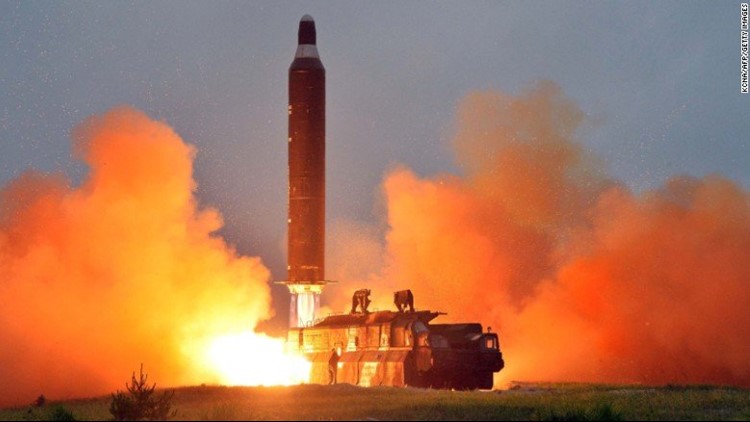(CNN) — North Korea’s latest missile test has sparked the familiar round of international condemnation and new fears that the US mainland is now in reach of the country’s arsenal.
Here’s what you need to know.
What happened on Friday?
North Korea launched the longest-range intercontinental ballistic missile it has ever tested — and the second ICBM this month.
It flew for about 45 minutes, going 3,700 kilometers (2,300 miles) high and for a distance of 1,000 kilometers (621 miles), according to analysis from the US and its allies.
North Korean leader Kim Jong Un touted the test as a success and claimed the “whole US mainland” is now within range of his missiles.
US President Donald Trump condemned the missile launch and said the United States would act to ensure its security.
Why is this different?
The latest test shows that Pyongyang’s missile program may be more advanced than previously thought.
If the missile was fired on a flatter, standard trajectory, it would have major US cities such as Los Angeles, Denver and Chicago well within its range, with the possible ability to reach as far as New York and Boston, according to David Wright, a missile expert at the Union of Concerned Scientists.
North Korea also claimed Friday’s test was designed to show the missile’s maximum range when equipped with a “large-sized heavy nuclear warhead.”
But last week a US official told CNN that the US government doesn’t believe North Korea will be able to launch a reliable, nuclear-capable intercontinental ballistic missile until early 2018.
The official said that while North Korea can currently get a missile “off the ground,” a lot of undetermined variables remain about guidance, reentry and the ability to hit a specific target.
What do the experts say?
Some experts are skeptical of North Korea’s claims, pointing out that the size of the missile’s payload is unknown. The heavier the payload, the shorter the usual range.
“We don’t know the mass of the payload used in the test; if a real warhead is significantly heavier, that would reduce the range the missile could reach,” the Union of Concerned Scientists’ Wright told CNN.
One thing is clear: Friday’s test marked a big step forward for a country once deemed incapable of developing a serious ICBM program.
How did the US and its allies respond?
The US and South Korea conducted live military exercises in a show of force hours after the test.
The US also sent two B-1 bombers on a 10-hour round trip over the Korean Peninsula on Saturday.
On Sunday, the US conducted a test of its THAAD missile defense system, but the THAAD system is not capable of intercepting ICBMs, and the test had been scheduled since earlier this month.
On the diplomatic front, US officials spent the weekend reassuring its allies in the region and warning North Korea to end its missile tests and nuclear program.
Trump renewed his criticism of China, claiming in a tweet that it has done “NOTHING” to rein in North Korea, while Vice President Mike Pence said “all options are on the table” when it comes to the rogue country.
On Sunday, US Ambassador to the UN Nikki Haley echoed Trump’s stance, saying that “the time for talk is over” and that Washington would not seek UN Security Council action following the latest missile test.
Are there additional concerns to consider?
North Korea has long maintained that the only way to protect itself against US-led attempts at regime change is through the threat of a nuclear attack.
According to a US defense official, evidence of an “ejection test” — which examines a missile’s “cold-launch system” — was carried out on land at the Sinpo Naval Shipyard, a port city on the Sea of Japan, on Sunday.
It was the third ejection test carried out in July, and the fourth demonstrated this year.
The latest ejection test is further evidence that Pyongyang is trying to beef up its nuclear capabilities, as were “highly unusual and unprecedented levels” of North Korean submarine activity detected earlier in July.
In that instance, North Korea sent a diesel-powered Romeo-class sub around 100 kilometers (62 miles) out to sea in international waters — farther than it had ever traveled. North Korea had also been outfitting its Gorae sub with a possible missile launch demonstration tube.
US and South Korean forces raised their alert levels slightly after detecting the subs’ atypical training activity.
North Korea’s submarine fleet is believed to encompass around 70 vessels, but most are outdated and are probably unable to fire missiles.
Without offering any specifics, US President Donald Trump said his administration would be able to take care of North Korea.
“We will handle North Korea. We are gonna be able to handle them. It will be handled. We handle everything,” Trump told reporters at his second full Cabinet meeting.



